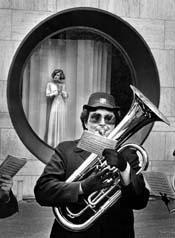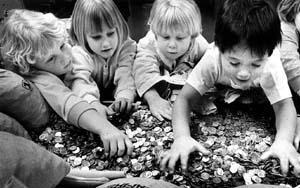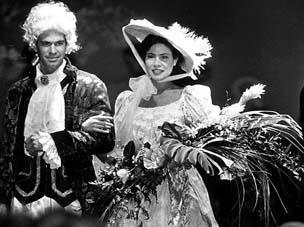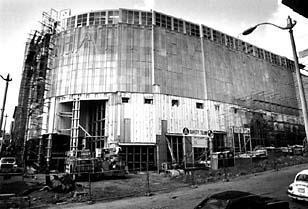
The Salvation Army band has become a familiar symbol of the holiday giving season. Lt. Virginia Wilson played her baritone in front of a Westlake Mall store in 1983. Photo Credit: Peter Haley / Seattle Times.
THE WORLD'S RICHEST MAN LIVES IN THE SEATTLE AREA,
but so do the several thousand homeless people who filter through its streets, back alleys
and shelters on any given day. Often acclaimed as one of the nation's most liveable cities,
Seattle still must acknowledge that nearly 12 percent of its citizens live below the poverty level.
The region is increasingly recognized for its expanding economic opportunities, vibrant arts community and reinvigorated retail core.
But behind the new cosmopolitan image lie the all-too-common urban problems of unemployment, hunger and disease.
While political debates continue ceaselessly over government's
role in stimulating cultural development and addressing the needs of society's have-nots,
the community has stepped up its own efforts to help. The spirit of giving, while spurred
by sizable corporate donations as well as the philanthropy of old-monied families and high-tech
millionaires, is also based in grass-roots volunteerism and neighborly concern.
Photo Credit: Angela Gottschalk / Seattle Times. Churches have often led community efforts to help the needy. John Williams,
left, founder of the Family Kitchen at St. James Cathedral, and volunteer
Idell Williams prepare a meal.
Churches have often led community efforts to help the needy. John Williams,
left, founder of the Family Kitchen at St. James Cathedral, and volunteer
Idell Williams prepare a meal.
SEATTLE'S CHARITABLE TRADITIONS EMERGED BEFORE THE TURN OF THE CENTURY
when the Gold Rush boomtown began its first period of significant growth. Government social-service
activities were almost nonexistent then, but churches, clubs and businesses offered critical
assistance to the city's poor and infirm.
Frontier entrepreneurs who made fortunes in the region's resource-based industries also financed civic enrichment, trying to re-create the cultural life they left behind in the East. Lumber baron C.D. Stimson, for example, helped found Seattle's first symphony, and shipping magnate David Skinner supported creation of the Cornish Institute; their families
continued this tradition of support for the arts.
Over time, area newspapers often served as philanthropic watchdogs, alerting readers to local needs and cajoling, occasionally shaming, them into action. The Seattle Times' campaign to bring Puget Sound the cultural benefits of an international fair -- the Alaska-Yukon-Pacific Exposition of 1909 -- included a front-page appeal for more donations:
"Why don't you come through with a little of the wealth Seattle has given you -- Rich Man?"

Preschoolers from the Childrens School in the University District dove into a wagonload of coins, part of the 1990
$3 Million Dimes appeal for the Emergency Feeding Program in King County.
Photo Credit: Benjamin Benschneider / Seattle Times.
BUT THE MAIN GOAL OF OTHER MONEY-RAISING EFFORTS SUCH AS THE TIMES FUND FOR THE NEEDY WAS TO ENCOURAGE BROADER COMMUNITY PARTICIPATION
in helping the unfortunate. The Fund began in 1927 to assist Seattle's 50 neediest families.
Over time, it changed its name and mission to address the area's most pressing charitable concerns,
using long-established service agencies such as the Salvation Army to administer distribution.
While the Fund brought in nearly $8,800 its first year, 1995 donations exceeded $480,000.
In the intervening time, the city matured and grew. The World War II boom brought
more wealth to the region and a recognition that both social and cultural progress required an
ongoing financial commitment. In 1946, eight civic leaders came together to establish the Seattle
Foundation, believing that "a community needs a philanthropical conscience to sustain its vitality." The foundation is still a custodian and clearing house for private donations to a whole range of charitable causes, and its endowments have steadily increased.
The post-war generation also included a number of individuals who, like the earlier
industrialists, established their own endowments or made gifts that helped build a richer cultural
tradition. Bagley Wright, Samuel Stroum, Leo Kreielsheimer and a few other key donors focused on
their first love, the arts, but also put up important seed money for a variety of social causes.
The 1962 World's Fair in Seattle is often cited as a turning point in wider
civic commitment to cultural organizations. The opening of the Opera House at the Seattle Center
marked the beginning of a growth spurt which over the next few decades brought new theaters,
performance halls and museums as well as renovated lodgings for a host of arts organizations.

Costumed models displayed items as auctioneer James Murphy urged bidders ever higher
at the PONCHO auction, one of Seattle's premier social events raising money for good causes.
Photo Credit: Benjamin Benschneider / Seattle Times.
FUNDING FOR THESE EFFORTS OFTEN CAME FROM A PARTNERSHIP OF PUBLIC AND PRIVATE INTERESTS,
but continuing support also came from newly formed charitable coalitions such as PONCHO
(Patrons of Northwest Civic, Cultural and Charitable Organizations) and the Corporate Council
for the Arts.
The '60s also saw a resurgence of national as well as community-based initiatives to end urban poverty and provide the disadvantaged with the resources and skills to better their lives. Diverse programs such as Neighbors in Need, the Open Door Clinic and the Central Area Motivation Program tried to fill the needs. Most only succeeded in the short term, but generated other long-lasting programs.
Despite this history of giving, Seattle was still considered somewhat of a philanthropic backwater, a country cousin to the more sophisticated, established East Coast networks. The vagaries of the region's economy often kept nonprofit agencies teetering between feast and famine.

Construction of a new Seattle Art Museum, opened in 1991, showed civic commitment
to the region's cultural health.
Photo Credit: Jim Berry/ Seattle Times.
IN RECENT TIMES, HOWEVER, LOCAL PHILANTHROPY HAS BEEN NEWLY INVIGORATED
by the success of many technology companies and a general economic upswing. Seattle now has at least
three billionaires -- Bill Gates, Paul Allen and Craig McCaw -- but is also, in the words of
Times columnist Emmett Watson, "up to its keister in millionaires." These high-tech baby boomers
have emerged as the next generation of givers, bringing a fresh idealism tempered with an attention
to the effectiveness of agencies that receive their gifts.
These mega-donors receive more media attention, but the rest of the citizenry has shared in supporting charitable causes. The recent United Way campaign in King County netted more than $51 million, while last year the per capita average for donations was highest in the country. The numerous volunteers who work at local foodbanks or day-care centers bear out Seattle Foundation director Anne Farrell's comment: "People here still think individuals can make a difference in their community."
The decision of where to make a difference often creates a certain tension as most individuals, with limited resources, are forced to make tough choices between social and cultural causes. Yet if Seattle's traditional spirit of giving is any indication, the two can work hand-in-hand to enrich everyone's lives.
Historians Sharon Boswell and Lorraine McConaghy teach at local universities and do research,
writing and oral history. Original newspaper graphics courtesy of the Seattle Public Library.